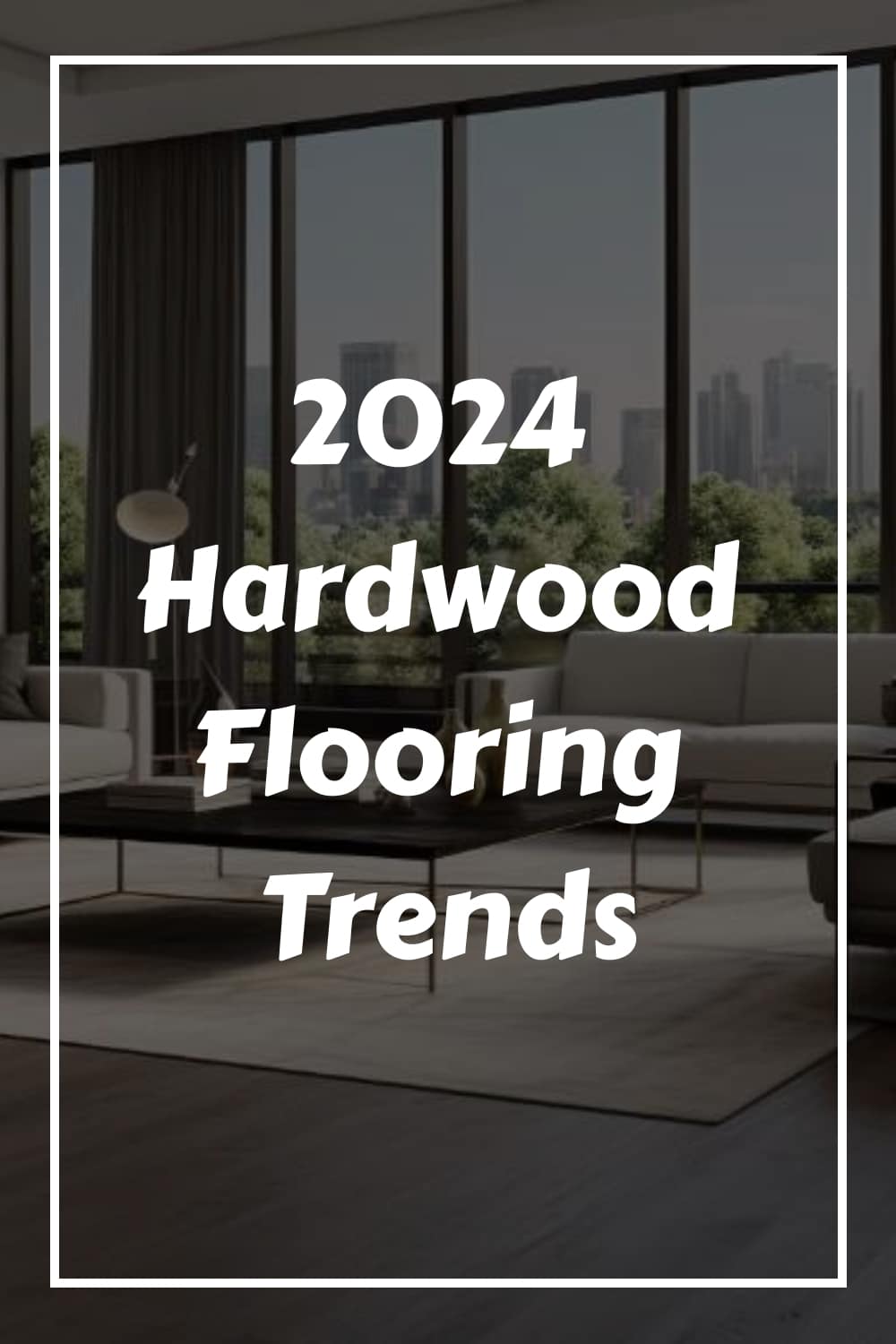
2024 Hardwood Flooring Trends You Should Know
Step into the future of home design with us as we unveil the enchanting world of hardwood flooring trends for 2024. Each plank tells a story of enduring beauty and cutting-edge design in this realm where elegance meets innovation. As we embark on this journey, imagine your home transforming under the spell of the latest trends in hardwood – from the eco-friendly sophistication of engineered wood to the rich, natural allure of medium wood tones. Ready to explore how these trends will redefine the heart of your home? Let’s dive into a world where every step on your floor brings a touch of timeless elegance and a whisper of tomorrow’s design ethos.
A remarkable ascent in popularity is seen in engineered wood. This innovation melds cost-effectiveness with environmental stewardship, challenging the traditional solid hardwood without sacrificing quality. Engineered wood’s stability and longevity make it a rising star among homeowners.
Statistical Insight: By 2024, the hardwood flooring market is forecasted to attain a staggering $41.68 billion market value, underscoring its unceasing allure and significance.
Smooth surfaces, raw wood tones, wide planks, and herringbone patterns define the current design zeitgeist. These elements infuse warmth and sophistication, transforming homes into welcoming havens. Following the home decor trends and 2024 flooring trends, these design elements bring warmth and sophistication, creating a welcoming atmosphere for residents and guests alike.
At Canadian Home Style, a leading flooring provider in Metro Vancouver, we anticipate a shift in floor colours towards raw medium tones of wood, with the white-washed blonds losing some of their previous popularity. This shift reflects the changing preferences of homeowners and their desire for a more natural and authentic look in their living spaces.
It is important to note that while hardwood flooring remains the preferred choice for over 50% of homeowners, alternative flooring options may suit individual preferences and budgets. Before deciding on your floor colour and material, it’s crucial to consider the pros and cons of each home decor trend and flooring option.
With the hardwood flooring industry poised to reach a market value of $41.68 billion in 2024, it’s clear that despite shifting floor colours and 2024 flooring trends, it retains its enduring appeal and value.
Key Takeaways
- Trendspotting: With its eco-friendliness and durability, engineered wood is a trend to watch.
- Design Directions: Smooth surfaces and raw tones are reshaping interior aesthetics.
- Market Movements: The anticipated $41.68 billion valuation of hardwood flooring by 2024 signals robust growth.
- Consumer Shifts: Preferences are migrating towards raw medium tones, indicating evolving tastes.
Diverse Design Elements:
- Natural Color and Textures: The gravitation towards raw medium tones and smooth surfaces mirrors an organic modern design ethos.
- Wide Plank Floors: The preference for wide planks, known for their luxurious feel and space-enhancing qualities, continues to rise.
- Minimalist Elegance with Light Wood: Light wood, synonymous with minimalist elegance, is gaining traction for its serene ambiance.
- Sustainability and Eco-Friendly Choices: An eco-conscious shift is visible, with sustainable materials like bamboo and cork becoming popular.
- Mixed-Width Planks and Pattern Play: Adopting mixed-width planks and intricate patterns exemplifies a shift toward personalization and creativity.
- Water-Resistant and Anti-Scratch Finishes: Innovations like the Mercier Intact 2500 finish cater to the growing demand for durable and maintenance-friendly floors.
- Parquet and Unique Patterns: The resurgence of parquet and unique patterns marks a return to artistic and timeless flooring designs.
- High-Contrast Design: Bold, high-contrast designs are gaining momentum, offering dramatic aesthetic statements.
- Medium-Tone Wood Flooring: Medium-tone wood overtakes white-washed blonds, favoured for its enduring elegance.
- Eye-Catching Herringbone and Chevron Patterns: Herringbone and chevron patterns are becoming the hallmarks of sophisticated flooring design.
Natural Color and Textures
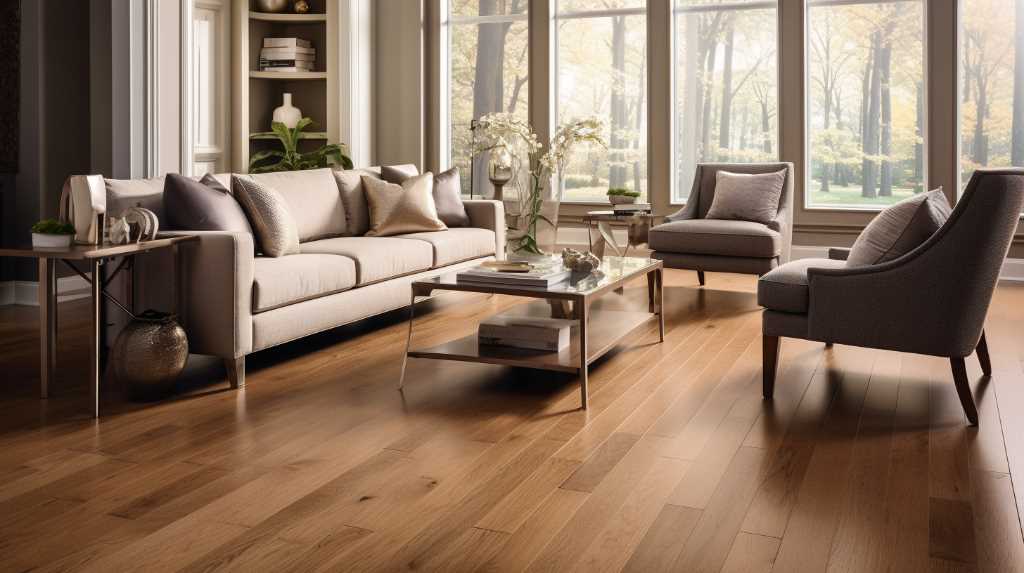
The hardwood flooring industry is experiencing a shift towards raw medium tones and smooth surfaces. This trend is driven by the growing preference for natural colour and textures, which add warmth and depth to any space. Homeowners and designers are increasingly drawn to the rustic charm and organic modern design these contemporary hardwood colours offer.
Raw medium tones of hardwood flooring perfectly embody the aesthetic of organic modern design, combining clean lines and minimalist sensibilities with the warmth and character of natural materials. These warm wood tones provide a versatile backdrop that can complement various interior styles, from traditional to contemporary. Whether paired with modern furniture or vintage pieces, they add a timeless elegance to any room.
Smooth surfaces play a crucial role in showcasing the natural beauty of hardwood flooring. Eliminating texture directs the focus toward the wood’s unique grain patterns and colour variations. This creates a visually cohesive and streamlined look, making the space feel more open and spacious.
It is important to note that while the trend towards raw medium tones and smooth surfaces is gaining popularity, homeowners and designers still prefer other colour options and textured finishes. However, the versatility and timeless appeal of raw medium tones make them popular among many.
Wide Plank Floors
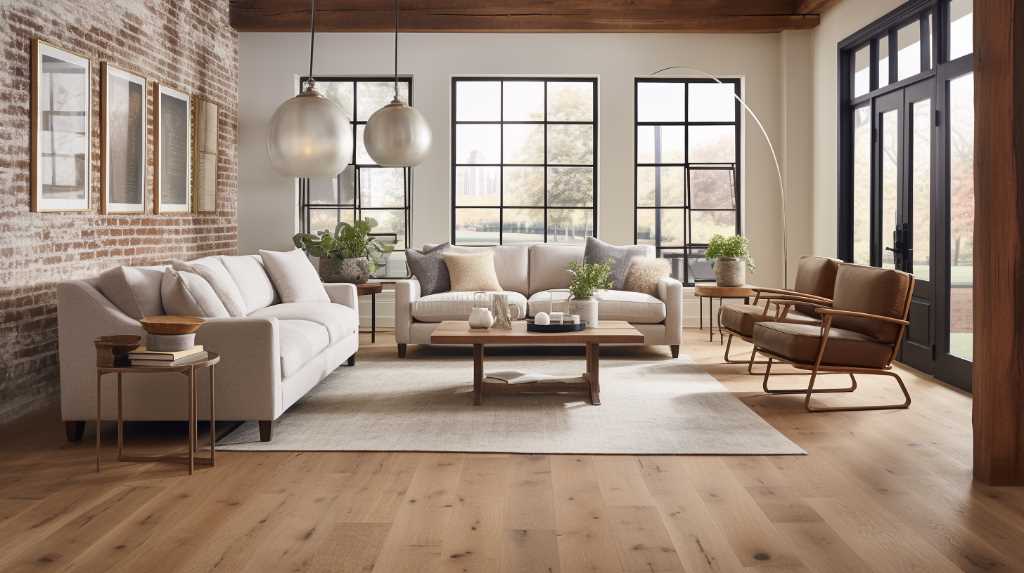
Wide plank floors have become popular in hardwood flooring because they create a sense of modern luxury and spaciousness. These wide planks, typically six inches or wider, offer a sleek and contemporary look that can elevate any space. Homeowners and designers alike are drawn to their open and grand appearance.
One of the main reasons behind the increasing popularity of wide plank floors is their ability to visually expand a room, giving the illusion of a larger space. With fewer seams due to the larger surface area of each board, wide plank floors provide a more seamless and uniform appearance. Not only does this enhance the overall aesthetic, but it also makes cleaning and maintenance easier.
Wide plank hardwood floors are versatile and can complement various interior design styles. Whether you prefer a rustic farmhouse aesthetic or a sleek and modern look, wide plank flooring can be customized to suit your preferences. With a wide range of wood species, finishes, and textures available, you can create a personalized and unique floor that adds character and warmth to your home.
While hardwood flooring continues to dominate the market, wide plank floors are expected to remain at the forefront of flooring trends. Their timeless appeal, versatility, and ability to create a sense of modern luxury and spaciousness make them a popular choice. So, if you’re considering upgrading your flooring, wide plank hardwood floors offer elegance and beauty that can transform your space.
Minimalist Elegance With Light Wood
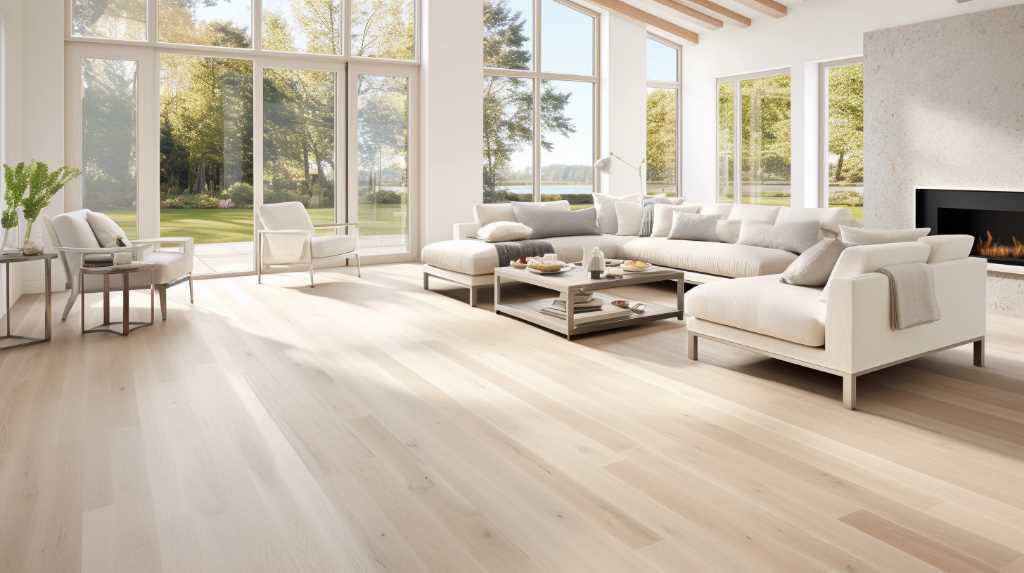
Light wood is becoming increasingly popular among homeowners and designers who appreciate the minimalist aesthetic. Its ability to create an atmosphere of elegance and simplicity is unmatched. Light wood is expected to take center stage in hardwood flooring trends for 2024, offering a timeless and sophisticated look to any space. Let’s explore why light wood is favoured by many:
- Emphasizing Natural Beauty: Light wood beautifully showcases the intricate patterns and textures of the grain. Its soft, pale tones exude tranquillity and harmony, creating a serene ambiance for those seeking a minimalist design.
- Versatility Across Interior Styles: Light wood effortlessly complements various interior styles, from Scandinavian to contemporary. Its neutral hue seamlessly blends with various colour schemes, allowing endless design possibilities.
- Creating an Illusion of Space: Light wood can visually expand a room, making it appear larger and more open. This is particularly beneficial for smaller spaces or rooms with limited natural light, as it creates an airy and inviting atmosphere.
- Timeless Elegance: Light wood possesses a timeless charm that transcends trends and fads. Its understated elegance adds a touch of sophistication to any interior, ensuring that your flooring choice will remain stylish for years to come.
While the demand for a minimalist aesthetic grows, light wood remains a top choice for homeowners and designers alike. Its natural beauty, versatility, ability to create an illusion of space, and timeless elegance make it an excellent option for those looking to create a sophisticated and refined atmosphere in their homes. Whether you prefer a Scandinavian-inspired design or a contemporary aesthetic, light wood flooring will elevate your space to new heights of elegance and serenity.
Sustainability and Eco-friendly Choices
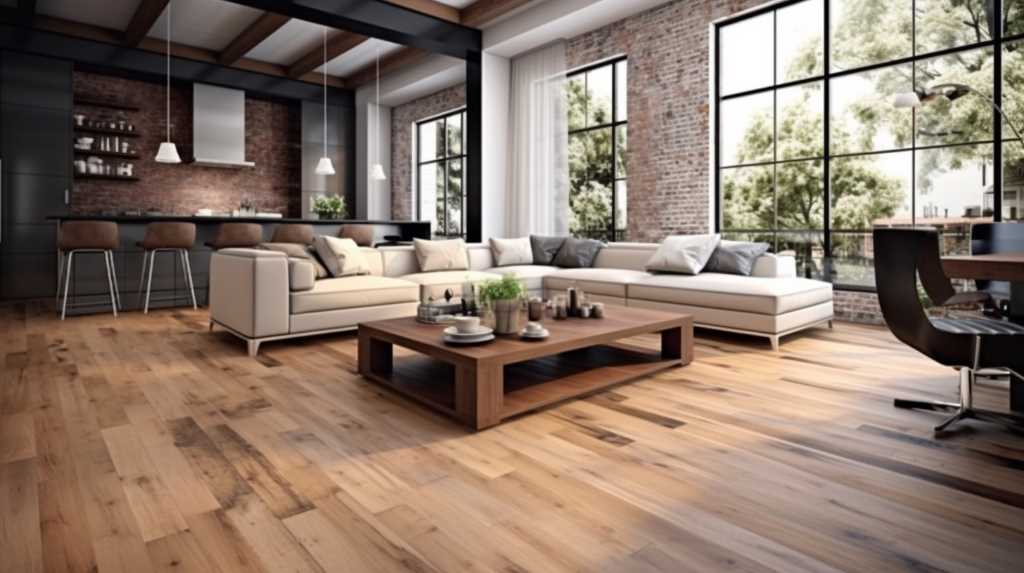
The hardwood flooring market is increasingly emphasizing sustainability and eco-friendly choices. As experts, we understand the importance of considering our environmental impact when choosing flooring materials. Consumers are increasingly conscious of this and actively seeking options that align with their values.
In the contemporary flooring industry, a significant shift towards sustainable wood flooring options is not just a trend but a paradigm shift reflecting a deeper global consciousness about environmental stewardship. Central to this transformation is the increasing preference for FSC (Forest Stewardship Council)-certified hardwood, which marries aesthetic appeal with ecological responsibility.
FSC certification is pivotal in this context. It ensures that the wood used for flooring comes from responsibly managed, socially beneficial, environmentally conscious, and economically viable forests. The certification process involves stringent assessments and audits to ensure the wood products comply with the highest environmental and social standards. According to the FSC, over 200 million hectares of forest worldwide are certified under their system, which is a testament to the growing global commitment to responsible forest management.
The appeal of sustainable wood flooring options extends beyond environmental responsibility. Homeowners are increasingly drawn to the unique beauty and durability of these materials. Unlike conventional flooring, each piece of FSC-certified wood carries a unique story of sustainable sourcing, contributing to a more meaningful and ethical home environment.
Statistically, the demand for eco-friendly home products, including sustainable wood flooring, has risen substantially. A report by Grand View Research indicated that the global eco-friendly furniture market size was valued at USD 35.2 billion in 2019 and is expected to grow at a compound annual growth rate (CAGR) of 5.9% from 2020 to 2027. This growth is partly attributable to the increasing consumer preference for sustainable materials in home décor and construction.
Sustainable wood flooring, notably, doesn’t just resonate with ecological and aesthetic values but also with economic sense. In the long run, the durability of these materials means reduced replacement and maintenance costs. Moreover, a growing market premium for homes that incorporate sustainable materials can enhance property values. A study by the University of Texas found that homes with green certification sold for an average of 8% more than similar homes without certification.
Furthermore, these sustainable choices align with global efforts to combat climate change and deforestation. The World Bank reports that sustainable forest management can help reduce carbon emissions and enhance carbon sequestration. By choosing FSC-certified wood, consumers play a role in this larger environmental narrative, supporting forest ecosystems crucial for biodiversity and climate regulation.
However, it’s crucial to acknowledge the challenges in embracing sustainable wood flooring. The initial cost can be higher than conventional options, and availability might be limited depending on the region. Despite these challenges, the long-term benefits of sustainability, both for the individual and the planet, make it a compelling choice.

On the other hand, it’s important to address the opposing viewpoint that sustainable wood flooring options may be more expensive or limited in variety. While it’s true that some sustainable choices may come at a higher price point, the long-term benefits and positive environmental impact outweigh the initial investment. Furthermore, the hardwood flooring market now offers a wide range of sustainable options, ensuring consumers find a style that suits their taste and design preferences.
Another perspective to consider is the availability of eco-friendly flooring materials beyond traditional hardwood. Cork, for instance, is a top choice due to its renewable and biodegradable properties. Linoleum, made from natural materials like linseed oil and cork dust, is another sustainable option. Recycled carpets, made from post-consumer materials, are also gaining popularity among environmentally conscious consumers. These materials offer a variety of colours and textures, allowing homeowners to create unique and environmentally friendly spaces.
The opposing point of view suggests that eco-friendly flooring materials may lack durability or aesthetic appeal. However, advancements in technology have addressed these concerns. Cork flooring, for example, is now available in various styles and finishes, providing durability and visual appeal. Similarly, modern linoleum options offer a variety of designs and patterns, making them suitable for any aesthetic preference. By debunking these misconceptions, consumers can confidently choose eco-friendly materials without compromising quality or style.
When selecting sustainable and eco-friendly flooring options, it’s essential to consider certifications such as Forest Stewardship Council (FSC) or Leadership in Energy and Environmental Design (LEED). These certifications guarantee that the products have been produced using sustainable practices and meet strict environmental criteria. Homeowners can be confident in contributing to a more sustainable future by choosing certified products.
Mixed Width Planks and Pattern Play
Using multiple-width planks and creative patterns in the hardwood flooring industry is an emerging concept we in the Lower Mainland have been pioneering for years. This trend, mixed-width planks and pattern play offers any space a unique and artistic touch. It allows homeowners to express their style and create a beautiful flooring design.
Mixed-width planks and pattern play can evoke emotion in the audience in two distinct ways. Firstly, the endless possibilities of mixed-width planks allow homeowners to experiment with different widths of wood planks, resulting in a visually stunning effect. The creative options are limitless, whether a combination of narrow and wide planks or various widths. This empowers homeowners to showcase their creativity and make a bold statement in their living space.
Additionally, pattern play takes mixed-width planks to the next level by incorporating geometric shapes into the design. From herringbone and chevron patterns to intricate parquet designs, including geometric shapes, add sophistication and elegance to the flooring. These patterns enhance the visual appeal and create a sense of movement and depth in the space.
Incorporating mixed-width planks and pattern play into hardwood flooring allows homeowners to create a unique and personalized look. This trend adds character to the space and increases the home’s overall value; whether a modern and sleek design or a more traditional and rustic look, mixed-width planks and pattern play offer homeowners endless possibilities to showcase their style and make a statement with their flooring choice.
Water-resistant and Anti-scratch Finishes

The demand for water-resistant and anti-scratch finishes in the hardwood flooring industry has significantly increased alongside the popular mixed-width planks and pattern play trend. As experts in the field, we understand the importance of providing innovative finishes that offer durability and longevity to meet the needs of homeowners seeking luxury hardwood designs and modern wood flooring styles.
One notable solution that has emerged in the market is the Mercier Intact 2500 finish. This performance-grade finish, originally designed for commercial applications but now available for residential use, stands out with its impressive anti-scratch rating. It surpasses all competitors in the industry by withstanding up to 2500 cycles in industry-standard Taber testing. Moreover, the Intact 2500 finish excels in scratch resistance and provides waterproof properties, making it an ideal choice for moisture-prone areas like kitchens and bathrooms.
The introduction of waterproof hardwood solutions has brought about a revolution in the hardwood flooring industry. Homeowners no longer need to compromise on the aesthetic appeal of natural wood floors in areas where water exposure is a concern. With the Mercier Intact 2500 finish, they can enjoy the beauty of hardwood while benefiting from its water resistance and anti-scratch properties.
These innovative finishes offer practical benefits and enhance the space’s overall appeal. A protective finish enhances luxury hardwood designs, maintaining the floor’s beauty and longevity. Homeowners can confidently choose hardwood flooring for their homes, knowing that with water-resistant and anti-scratch finishes like the Mercier Intact 2500, their floors will withstand the test of time and daily wear and tear.
The consensus among experts in the hardwood flooring industry is that the desire for aesthetic appeal and functionality drives the demand for water-resistant and anti-scratch finishes. However, it is important to address the opposing point of view that questions the necessity of such finishes. Critics may argue that traditional hardwood finishes are sufficient and that the additional features provided by water-resistant and anti-scratch finishes are unnecessary. However, this perspective fails to consider the increasing demand for flooring solutions that can withstand the challenges of daily life and provide long-lasting beauty.
Parquet and Unique Patterns
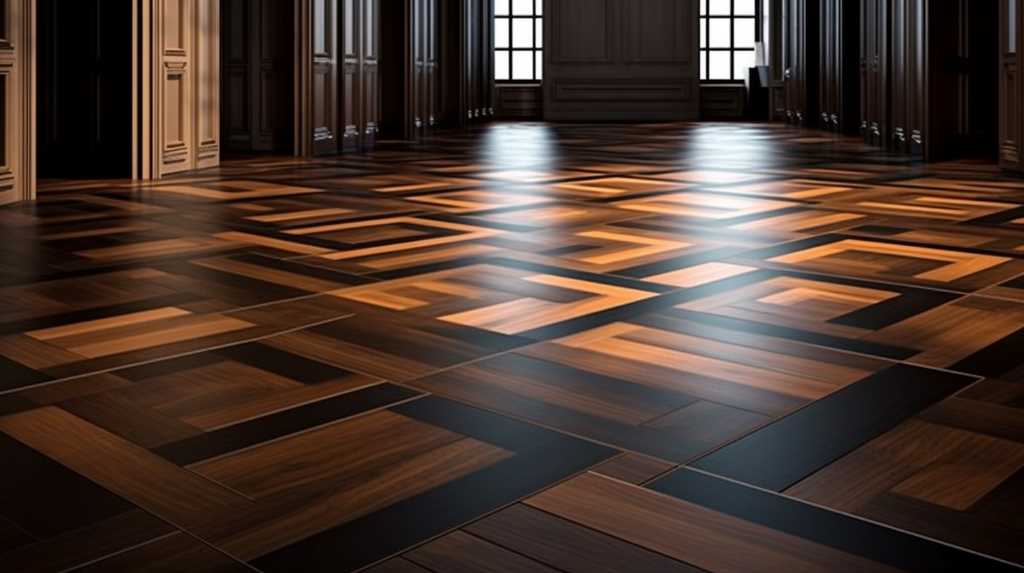
The hardwood flooring industry is witnessing a notable trend towards the growing popularity of parquet and unique patterns. Homeowners and designers are embracing these patterns to add a touch of artistic flair to their spaces, moving away from conventional straight plank installations. Here are some compelling reasons why parquet and unique patterns have captured the attention of industry experts and homeowners alike:
- Versatility: Parquet and unique patterns allow homeowners to express their creativity and infuse their space uniquely. Whether it’s a herringbone or chevron pattern, these designs can instantly elevate the aesthetic appeal of any room.
- Timeless Elegance: Parquet and unique patterns have stood the test of time, dating back to the 17th century. Their enduring popularity is a testament to their timeless elegance and ability to enhance any interior’s beauty.
- Visual Interest: Parquet and unique patterns offer captivating visual interest, unlike traditional plank installations. The intricate arrangements of the wood create dynamic movement and texture, making a bold statement in any room.
- Customization: With parquet and unique patterns, homeowners can customize their flooring to suit their style and preferences. The possibilities are endless, from different wood species to various finishes, enabling individuals to create a truly unique space.
- Alignment with Flooring Trends: Parquet and unique patterns are at the forefront of current flooring trends. Designers and homeowners are embracing these patterns to add personality and character to their spaces, moving away from conventional designs and embracing a more artistic approach.
Parquet designs and unique patterns often come under scrutiny for their perceived drawbacks. Critics argue that these intricate designs demand additional time and monetary investment during installation. However, this critique fails to fully capture the essence of wood flooring and its potential to bring personality and character to a space.
Wood flooring, in its various forms, has a remarkable ability to infuse a room with its own unique essence. Like a fingerprint, each hardwood surface tells a story of craftsmanship and natural beauty. Parquet designs, with their interlocking geometric patterns, speak to a sense of precision and artistry that can transform any space into a work of art.
To truly appreciate the value of wood flooring, one must understand its ability to convey a sense of personal style and individuality. Imagine a room with a traditional oak floor, its warm honey tones inviting you to embrace a timeless embrace. Now, envision a room with a bold and daring herringbone pattern, capturing the attention of all who enter. These artistic choices reflect the personalities and tastes of the individuals who have carefully curated their spaces.
The installation time and cost of Parquet and unique patterned wood flooring may be greater than that of more standard options. However, in return, they offer a visual feast for the senses – a statement piece that elevates the aesthetic appeal of any room. So, let us not dismiss the value of investing in these distinctive flooring choices, for they can transform ordinary spaces into extraordinary realms of self-expression.
At Canadian Home Style, we believe that parquet and unique patterns offer homeowners and designers an exciting opportunity to create truly memorable spaces. Their versatility, timeless elegance, captivating visual interest, customization options, and alignment with current flooring trends make them a top choice for those seeking to make a statement with their flooring choices. Whether it’s a classic herringbone or a more whimsical geometric design, parquet and unique patterns will leave a lasting impression.
High-Contrast Design
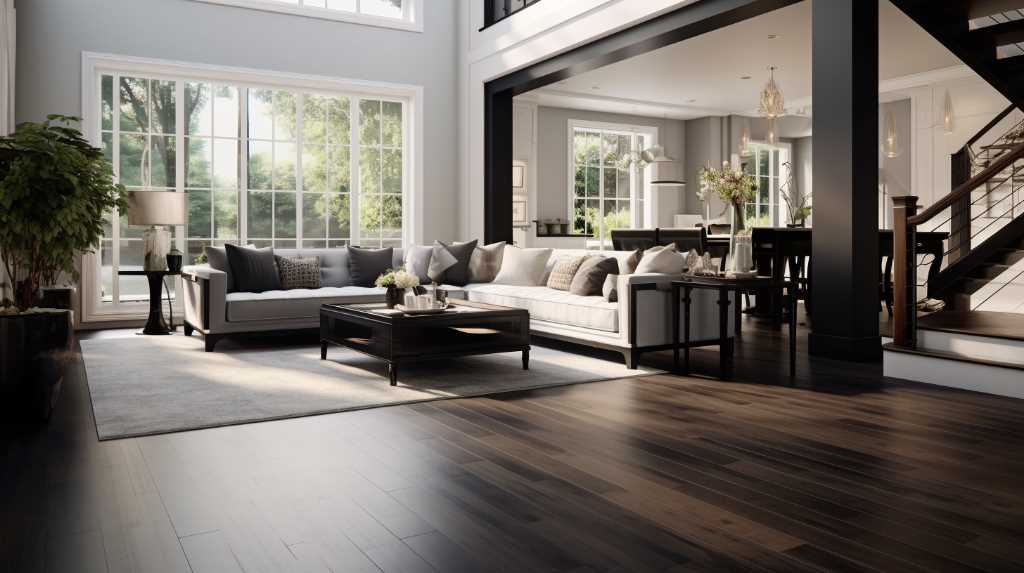
The demand for high-contrast design in hardwood flooring has been increasing, reflecting the evolving preferences of homeowners. Bold and dramatic design choices are becoming more popular, and high-contrast flooring aligns perfectly with this aesthetic. Therefore, there’s still a place for dark wood floors in 2024. Dark wood floors, in particular, have emerged as a statement feature in many modern homes.
In hardwood flooring trends, high-contrast design refers to the striking combination of light and dark tones. This creates a visually captivating and dynamic look that enhances the overall aesthetic of a space. The contrast can be achieved by using different types of wood, such as pairing light-coloured oak with rich, dark walnut or ebony. Alternatively, homeowners can utilize staining techniques to highlight the natural colour variations within a single wood species.
The appeal of high-contrast design lies in its ability to create a focal point in a room. Dark wood floors, in particular, draw the eye and make a bold statement. They provide depth and sophistication, adding a touch of luxury to any space. The contrast between dark flooring and lighter furniture or walls creates a visually striking and contemporary look.
High-contrast design is not limited to specific interior styles. Whether a modern, minimalist space or a traditional, classic setting, dark wood floors can add drama and elegance. It complements various colour schemes and furniture styles, making it a versatile choice for homeowners seeking to create a unique and impactful design.
It is important to note that high-contrast design is not the only option for hardwood flooring. Some homeowners may prefer a more uniform and subtle look, which is perfectly valid. However, it is worth considering the visual interest and sophistication that high-contrast design can bring to a space.
Medium-tone Wood Flooring over White-washed Blonds
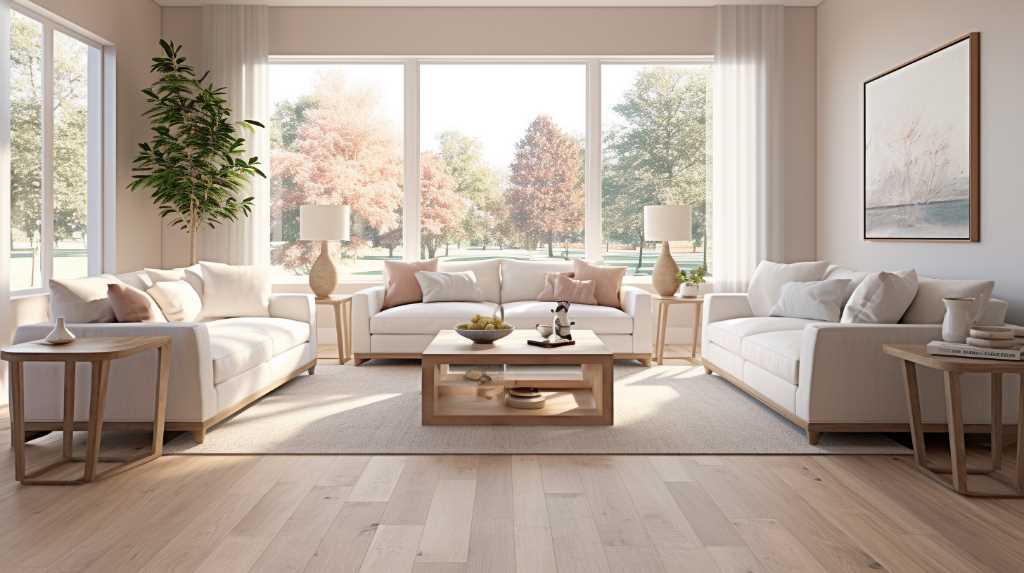
Medium-tone wood flooring is gaining more popularity than white-washed blonds, which were the talk of the town in 2023. We can see that homeowners are increasingly drawn to the natural beauty and warmth that medium-tone wood flooring brings to their living spaces. Let’s explore why medium-tone wood flooring is preferred over white-washed blonds.
One compelling reason is the timeless elegance that medium-tone wood flooring offers. Its rich and warm hues effortlessly enhance any interior design style. The natural grain patterns of medium-tone wood flooring add depth and character to a space, creating a cozy ambiance. Whether paired with contemporary furniture or traditional decor, medium-tone wood flooring brings a sense of sophistication and charm that never goes out of style.
Another reason for its popularity is the versatility and durability of medium-tone wood flooring. It provides homeowners a versatile canvas to express their style, complementing various colour palettes. Moreover, medium-tone wood flooring is known for its durability and resistance to wear and tear, making it a wise long-term investment.
While white-washed blonds have been so popular in the past couple of years, homeowners are now gravitating towards the warmth and depth that medium-tone wood flooring brings to their living spaces. Whether a cozy farmhouse kitchen or a modern urban loft, medium-tone wood flooring stands the test of time.
Gone are the days when purity and lightness ruled the roost. Many opinions coexist in this era of diversity and open-mindedness, like a symphony of voices harmonizing in perfect unity. While some still cling to the ethereal beauty of white-washed blonds, many design connoisseurs are placing their faith in medium-tone wood flooring. And as experts in the field, we wholeheartedly endorse this shift in preference.
Eye-catching Herringbone and Chevron Patterns
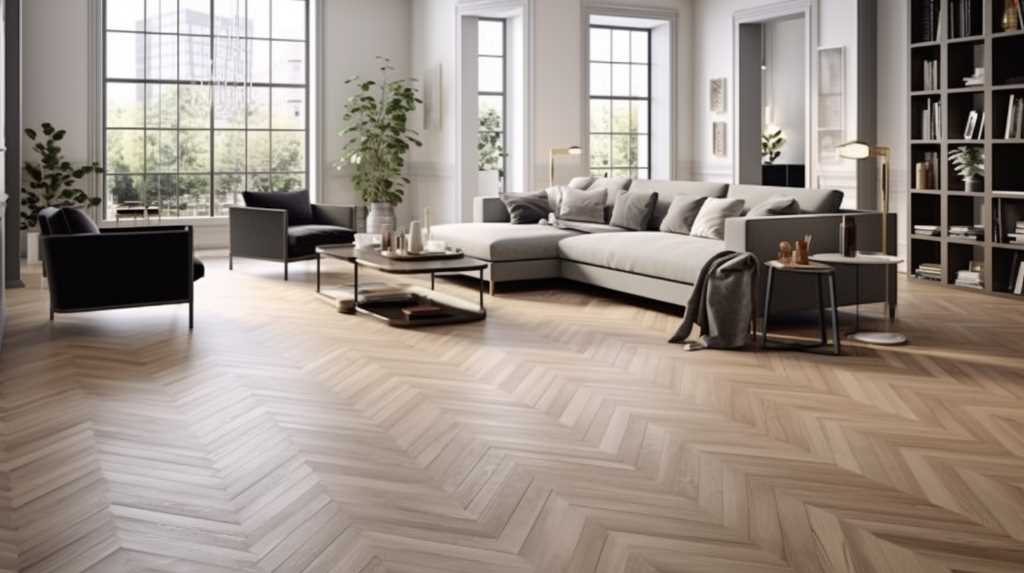
Herringbone and chevron patterns have become increasingly popular in the hardwood flooring industry in recent years. These intricate designs add depth, texture, and visual interest to interior spaces, making them a top choice for homeowners and designers. The herringbone pattern, characterized by its distinctive V-shaped zigzag design, creates a timeless and elegant look. It can be installed using traditional solid wood planks or engineered wood, offering versatility in design and installation options. On the other hand, the chevron pattern features a continuous zigzag pattern that creates a more modern and dynamic aesthetic.
Both herringbone and chevron patterns can be customized with various wood tones, allowing homeowners to choose the perfect shade to complement their decor. These patterns are embraced in various interior spaces, from traditional living rooms and dining areas to contemporary kitchens and entryways. Homeowners are drawn to these patterns because they provide a unique and visually appealing focal point, enhancing the space’s overall design. Additionally, herringbone and chevron patterns can visually expand smaller rooms, creating the illusion of a larger and more open area.
Working with experienced flooring professionals specializing in intricate installations is important to achieve the best results with herringbone and chevron patterns. They have the expertise to ensure proper alignment, seamless transitions, and a flawless finish. With the growing demand for these patterns, the availability of skilled craftsmen is increasing, making it easier for homeowners to incorporate this trendy flooring option into their homes.
Hardwood flooring Statistics
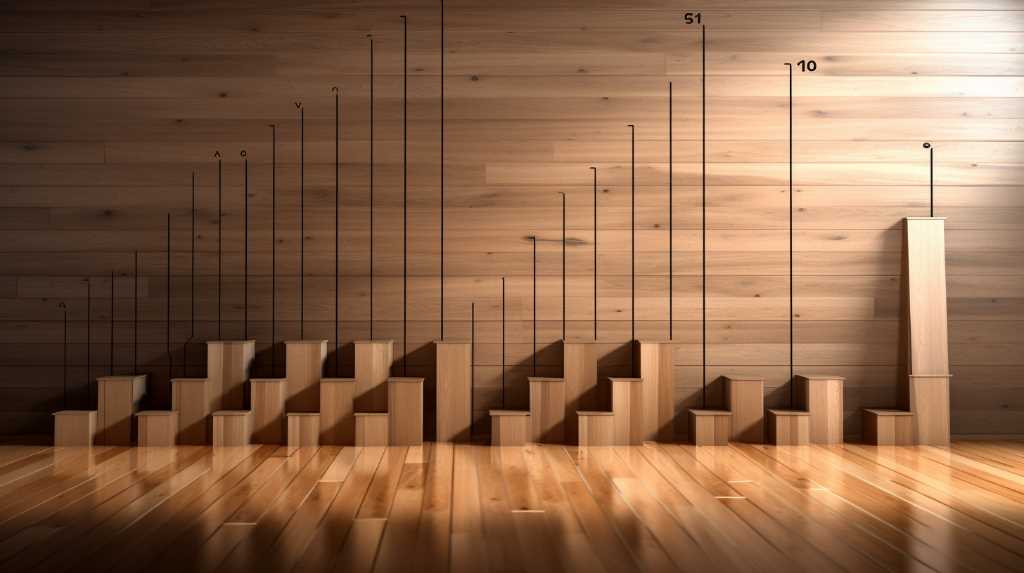
The hardwood flooring industry is experiencing significant growth, with projections indicating that it will reach a value of $41.68 billion by 2024. This growth reflects the increasing preference among homeowners for hardwood flooring, which holds timeless appeal and adds value to homes. However, it is important to consider the emerging trends and challenges in the market.
One notable trend is the rising popularity of engineered hardwood flooring, with an expected annual growth rate of 6.8%. Homeowners are drawn to the durability and versatility of this type of flooring. It offers a practical solution for those seeking long-lasting and low-maintenance flooring options.
While most homeowners prefer hardwood floors, it is essential to acknowledge that there are different perspectives on this matter. Some homeowners may choose other flooring options based on their needs and preferences. It is crucial to understand and respect these individual choices.
Another trend worth noting is the increasing demand for waterproof hardwood flooring, which has seen a 15% rise in the past year. This indicates that homeowners are placing a higher priority on durability and water resistance when selecting their flooring. Waterproof options provide peace of mind and ensure the flooring can withstand everyday spills and moisture.
Industry professionals and homeowners should consider these statistics when deciding on hardwood flooring. It is important to consider factors such as durability, versatility, and water resistance to meet the diverse needs of homeowners. Industry professionals can guide homeowners toward the most suitable flooring options by staying informed about the latest trends and market insights.

Frequently Asked Questions
What Color Wood Floors Are in Style 2023?
Wood floors in 2023 embrace natural, warm tones that create a harmonious connection to the environment. The trend towards light wood flooring reflects a minimalist elegance, adding sophistication and a bright, airy atmosphere to any space. Experts in the field widely favour this style choice, as it complements various interior design styles and creates a timeless appeal.
Opposing views may argue that darker wood floors will be more stylish in 2023. However, this perspective fails to recognize the growing preference for light wood flooring among homeowners and designers. Light wood floors not only enhance the overall aesthetic of a room but also offer practical benefits such as making smaller spaces appear larger and increasing the area’s brightness.
From a different perspective, one might ask, “What makes natural, warm wood tones so popular in 2023?” The answer lies in the desire for a connection to nature and a sense of tranquillity in living spaces. With modern life’s increasing hustle and bustle, many individuals seek solace and serenity in their homes. Natural wood floors provide a grounding element, bringing a touch of the outdoors inside and creating a peaceful ambiance.
Considering the current market trends and consumer preferences, it is evident that light wood flooring is the top choice for style-conscious individuals in 2023. Its ability to effortlessly blend with various design aesthetics brightens up spaces, and its timeless appeal makes it a go-to option for homeowners and designers alike. So, if you’re looking to update your flooring, embracing the natural, warm wood tones of light wood flooring is a decision experts recommend for both style and functionality.
What Is the Trend in Hardwood Floors in 2024?
In 2024, the prevailing trend in hardwood floors leans towards embracing raw medium tones of wood, moving away from the popularity of white-washed blonds. As experts in the field, we observe a strong preference among homeowners for the timeless beauty and durability of hardwood flooring. Additionally, there is an increasing demand for waterproof hardwood flooring catering to the practical needs of modern households.
While the shift towards raw medium tones is gaining momentum, it is important to note that personal preferences and design choices may still vary. Some individuals may still opt for white-washed blonds or other unique finishes to achieve a distinct aesthetic. However, the overall consensus points towards the rising popularity of raw medium tones in hardwood flooring.
From a broader perspective, this trend reflects a desire to connect with nature and create a warm, inviting atmosphere in living spaces. Raw medium tones offer a sense of authenticity and rustic charm, bringing the beauty of nature indoors. It is a departure from the sleek and minimalist styles of the past, as homeowners seek to infuse their spaces with character and a touch of natural elegance.
Furthermore, the demand for waterproof hardwood flooring highlights the practicality and functionality that homeowners seek in their homes. With the advancements in technology and manufacturing processes, waterproof hardwood flooring provides a solution that combines the timeless appeal of hardwood with the ability to withstand moisture and spills. This addresses common concerns such as water damage and maintenance, making hardwood flooring a viable option for areas prone to moisture, such as kitchens and bathrooms.
What Is the Flooring Industry Trend in 2024?
Several key elements characterize the flooring industry trend in 2024. One prominent feature is the growing preference for smooth surfaces, which provide spaces with a sleek and modern aesthetic. Additionally, there is a shift towards using wide planks, which create a sense of spaciousness and add a touch of sophistication to any room.
Another trend gaining traction is the utilization of herringbone patterns in flooring design. This classic and timeless pattern adds visual interest and elegance to floors, making them a focal point in interior spaces. Homeowners and designers can achieve a sense of luxury and refinement by incorporating herringbone patterns.
In terms of colour, there is a noticeable inclination toward raw wood tones in 2023. This choice brings a natural and organic feel to spaces, creating a warm and inviting atmosphere. Medium tones of wood are particularly popular, with white-washed blonds losing popularity. This shift towards raw medium tones allows for greater versatility in design, as it complements various decor styles and colour palettes.
While these trends represent the consensus within the flooring industry, it is worth considering the opposing viewpoint. Some may argue that these trends lack novelty and originality, as smooth surfaces, wide planks, and herringbone patterns have been popular. However, it is important to note that trends often resurface and evolve as they continue to captivate and inspire homeowners and designers alike.
Choose Canadian Home Style for your Vancouver flooring projects.
Canadian Home Style is your family-owned and operated flooring retailer with a showroom in North Vancouver, BC. We provide full-service commercial and residential flooring solutions across the Lower Mainland with an extended warranty. We are proud BC Floor Covering Association (BCFCA) and the National Wood Flooring Association (NWFA) members. In addition, we have won the Consumer’s Choice Awards back-to-back in 2021, 2022, and 2023 for our commitment to business excellence. We are considered the highest-rated flooring experts in Metro Vancouver. We pride ourselves on holding the highest standards in the flooring industry. We have a strict policy of “not selling or displaying any products we wouldn’t want in our homes to uphold our high standards.” Before we select a product to feature, we carefully assess product quality, off-gassing, warranties, and responsible sourcing. Book now to visit our North Vancouver flooring showroom; we can help you choose the perfect floor for your home or business.
Our mission is to help homeowners create beautiful homes that reflect their lifestyles while reducing energy consumption and conserving resources. We provide our clients with innovative products, services and education. Our vision is to become Canada’s leading sustainable flooring solutions provider. Our values include integrity, respect, honesty and transparency. These principles guide us as we strive to provide outstanding customer service.
We believe that our success depends on the success of our clients and their customers. We work hard to ensure our clients get the most out of their investments. Our team consists of highly skilled professionals who are experts in their field. They have years of experience working together and know what works and what doesn’t. They understand how to solve problems quickly and efficiently. We are committed to providing excellent customer service. We listen carefully to our client’s concerns and suggestions. We take these into account when planning and executing projects. We always strive to exceed expectations.
Services We Offer:
Main Areas of Service in British Columbia:
Frequently Asked Questions for Flooring
What is engineered hard flooring?
Engineered hardwood is a product made up of a solid wood veneer over an engineered core. The engineered core construction can be layers of wood, lumber core, or composite materials. Engineered wood has a higher dimensional stability than solid wood, and can handle the modern design’s winder width. Engineered hardwood can be installed in many different ways. This has the benefit of adapting to your application and needs. Engineered hardwood flooring comes with a variety of widths, colours, and styles. In Metro Vancouver, wide plank oak flooring is the most commonly engineered hardwood floor.
Is engineered hardwood more durable than solid hardwood.
Engineered hardwood is stronger than solid hardwood. Engineered hardwood is less susceptible to warp, shrink, or cup over time. Engineered hardwood flooring will withstand structural changes. Engineered hardwood flooring can withstand such structural changes because it contains more stable species and wood species that can compensate for movement. The Baltic Birch of Russia is a great example, because it was grown in extremely cold conditions. This makes it a top choice for core building.
Engineered hardwood flooring has many advantages over solid hardwood. It can be installed in almost any style you choose. It can be glued, float, or stapled just like solid hardwood. It can be installed in almost any house location, even basements. These locations are not suitable for solid hardwood. It will quickly swell, become damaged or be very noisy for neighbors below.
What is laminate flooring?
Laminate is a durable, economical type of flooring material. Laminate is just like real wood. Most laminate floors’ core layer is made of melamine resin, fiberboard materials and the HDF core. The top layer of laminate flooring has a printed textured finish that looks and feels like real wood. Laminate flooring is available in many different textures and finishes. Laminate flooring can be installed on any type of subfloor and is easy to install. It is easy-to-clean and maintain.
How much does it cost to install flooring per square foot in Vancouver?
It depends on the type of flooring you choose and how the installation is done. The time taken to install your new flooring will vary. The installation cost should be between $2.00 – $5.00 per square foot in Vancouver. Laminate and luxury vinyl flooring costs $2.00 to $2.75 per square foot. Hardwood flooring is between $2.50 to $5.00 SF depending on the installation method. Floating hardwood can be the most cost-effective and time-saving option. It will take approximately 2.00 to 3.00 dollars per square foot. Installation of glue-down or nail-down hardwood is slower and will cost you $4.00 to $5.00 per sq foot.
Are wide plank floors more costly?
Yes Wide plank flooring is generally more expensive than the standard widths. This is especially true for hardwood flooring. Larger boards are more difficult to find which can add to costs. However, many homeowners feel that the added expense is worth the beauty and charm that wide plank floors can provide.
How much does wood flooring materials cost?
Make sure to do your homework before buying wood floors. There are many factors that influence the price of a wood floor. Here’s an overview of some important things you need.
- Wood finishes: Anti-scratch top coat Wood floors are no exception. You’re not only buying wood floors, but also finished wood floors. This is how you can enjoy the many benefits of the floor such as its water and scratch resistance capabilities. Manufacturers are proud to create their own patented finishes. The perfect finish will give hardwood its natural beauty and protect it from any staining.
- Country of Origin (where the product originated)As you can imagine, where the hardwood is manufactured into flooring planks will considerably influence the price. This is partly due to labour costs. The rest depends on quality control and standards. You get what you pay. It’s no surprise that Canada has a very strong hardwood manufacturing industry. Canada’s hardwood flooring products are highly valued and trusted by us. The rule of thumb is that hardwood flooring bought from low-wage countries, such China, will be of lower quality. This can lead to inferior finishes and reduced protection from daily use.
- Construction of Hardwood FloorYou might be aware that not all hardwood flooring is constructed similarly. In general, there are two major categories as follows:Hardwood – Hardwood flooring comes from a single block of wood and is generally cheaper than “engineered”. This is because there’s less labour involved in making solid wood compared to engineered hardwood. Solid hardwood flooring doesn’t have the same humidity stability as engineered hardwood floors. Contrary to popular belief solid wood flooring doesn’t perform better than Engineered Hardwood flooring. You can think of this as more stability because there are more layers of wood over each other. Because the wood’s expansion and contraction will be absorbed by the other layers of the flooring, it won’t affect its overall quality.
Engineered Wood – The engineered hardwood construction is specifically designed to be more durable in its environment. This type of wood flooring uses at least two types of wood to ensure stability. Engineered cores can be constructed from many different wood species. Prices vary depending on their availability. It is important to consider how your hardwood is built and what wood species are used. The Baltic Birch from Russia is much more expensive than Poplar because these two wood species are common in core construction. Products that have Baltic Birch cores instead of Poplar are often more expensive.
- Layer your lamella with a layerThis excludes solid hardwood, but the thickness of the wear layer can severely change the price of engineered hardwood. Lamella, also known as the wear layer or the thickness of hardwood above the engineered flooring’s core, is what the Lamella refers. You can expect the thickness of the wear layer to vary from 1 to 6mm. Typically, the thicker the wear layer, the more prolonged usage you’ll get out of your flooring. This is because it dramatically improves the flooring’s durability.
- Grading the HardwoodAs you probably know, every wood tree is different. When hardwood is harvested, it is graded to determine its quality.Grade AB, or Prime Grade, – This grade is typically taken from the centre of the timber log. There are very few colour variations and knots.
Grade ABC – Lower AB is “selectgrade” and contains slightly more knots. There are also more colour variations between planks.
Grade ABCD – This grade has more knots that the other two and can reach up to 30mm in diameter. It also holds a lot more sap within the wood.
In simple terms, the price of hardwood planks will change radically if it is free from knots.
- There are many species of hardwoodThere are many varieties of wood used in the flooring industry. Each species is unique and has its benefits and looks. It’s important to choose based upon your style preferences and the application you intend to use. Different woods can have wildly different prices. Santos Mahogany or American Walnut are more expensive than red oak or maple.
- Width and Length of the boardsYou can make your room appear larger or more open by installing longer, more natural hardwood planks. Your flooring may be more costly if your boards are longer or wider than they should be. A lack of trees that are suitable for wide planks means that manufacturers will waste more wood and create longer boards. Your hardwood flooring’s cost will depend on its width and length.
What is the difference in engineered and solid hardwoods?
Solid hardwood is solid wood throughout and usually 3/4″ thick. Engineered Wood is different from solid hardwoods. It contains layers that offer additional stability to an otherwise unstable frame. This makes engineered wood ideal for high-end homes that have very strict requirements.
One significant advantage to getting solid wood flooring is that it can be sanded and refinished at least three times. Solid hardwood flooring is ideal for those who want to change the colour of their floor or fix scratches. Engineered hardwood can also be sanded. You can sand and refinish engineered hardwood up to twice, but only if your top wear layer is thick enough. You must also staple or glue your wood floor if you intend to sand and refinish it in the future. Usually engineered floors are floated on a subfloor with a proper underneath. Floating floors cannot be sanded or refinished.
Engineered wood flooring is more dimensionally stable to humidity and temperature changes. The installation process for engineered hardwood flooring is simpler and more flexible than traditional hardwood. The plywood subfloor must be at least grade to hold a solid hardwood. With engineered hardwood, however, you have the option to choose which type of installation you prefer. These floors can be floated, stapled (similar to nail down), and glued to the subfloor. Engineered hardwood can also be installed below, above, or on grade. They can also be installed where solid hardwood is impossible, like in basements and condominiums with concrete subfloors. Engineered hardwood has another advantage: the stability of its core allows manufacturers to offer larger planks. While solid hardwood is limited to a maximum width of 5 inches, engineered hardwoods can reach up to 9 inches. This look is preferred, especially in the Lower Mainland and on the West Coast. Larger boards will make your home feel larger and more modern.
Statistics
- Amorim’s WISE WaterProof flooring is 100% waterproof, kid-proof, and pet-proof, giving you longer-lasting floors. (greenbuildingsupply.com)
External Links
youtube.com
en.wikipedia.org
How To
How do you ensure your job site’s readiness for flooring installation
- You should check the job site environment before delivery. Your job site must be prepared for flooring material delivery. Your subfloor MC content should be between 6-9%. Your job site temperature should be between 17 to 25 degrees Celsius. This temperature should correspond to the temperature you are most comfortable with. The relative humidity should not exceed 30-50%
- Re-check the conditions after delivery. Please remember that these conditions need to be maintained year long. This is especially true of laminate and wood flooring.
- At least 40 locations for each 1000 SF must be tested, plus four additional testing for each 100 SF. All of these results must be documented and kept safe by your flooring company.
- Any unusual moisture readings must be investigated and treated. These areas will need to be retested until the acceptable range is reached before they can be installed.
- The subfloor must be levelled. You can either pour a self-leveling material or grind the subfloor down before installing.
- Your flooring company should be notified immediately if you find that your job site is not available for installation.
How to remove glue residues from hardwood floors
You can remove most glue residues by using Methyl hydrate. This can be found at your local hardware store. Place a small amount Methylhydrate on the glued surface and allow it to rest for five minutes. Scrape off any glue with a putty spoon. You can wipe any residue off the area using a damp cloth.
You may also use a product called ‘Goof Off’. These products are available in most hardware shops. Follow the directions on the product. To get rid of any residue, you may have to apply it multiple times.
It is important to remove dust particles before using a cleaner. This job is best done with a vacuum. Next, clean the floor with a high quality cleaner. Apply a second cleaner if there is any residue.

